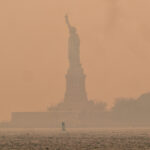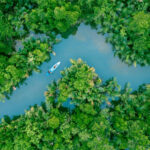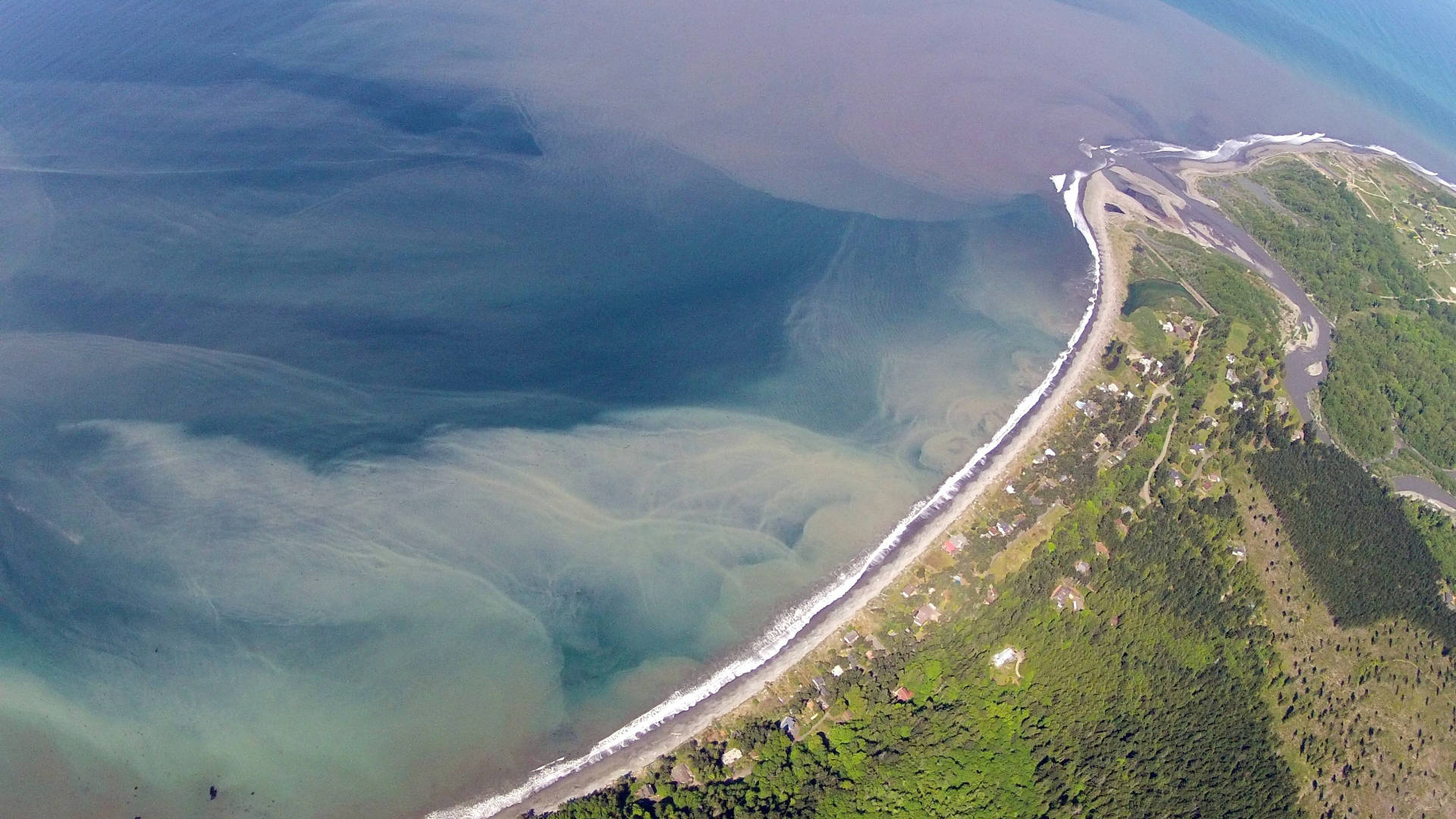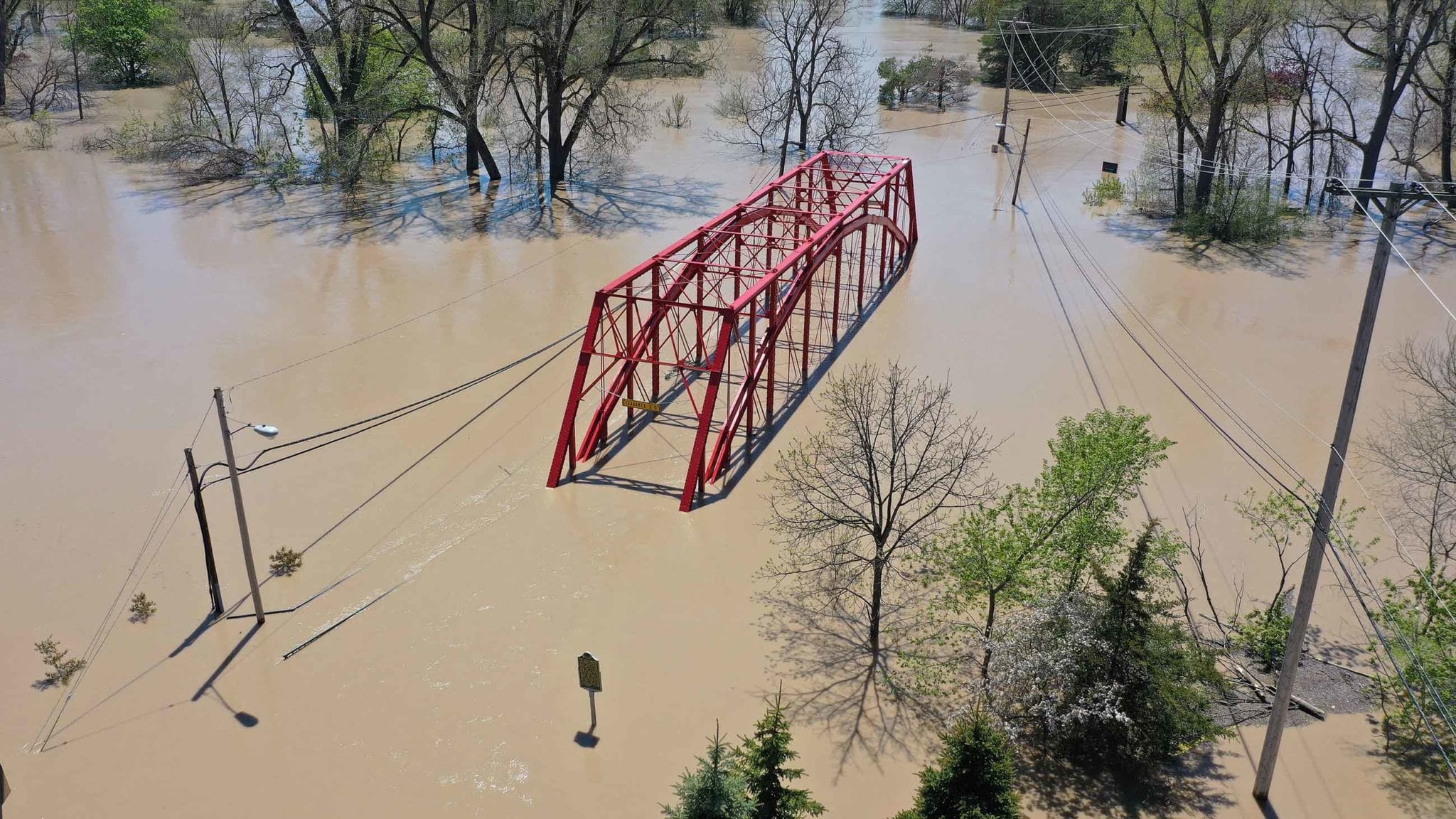On the Pacific Coast, Dam Removal Renews the Shoreline
In late August, Steve Rubin, a fish biologist with the United States Geological Survey, will dive into the frigid, briny water of the Strait of Juan de Fuca, roughly a mile from the mouth of the Elwha River. It will be Rubin’s 12th dive at the site since the Elwha Dam was breached in 2011, sending a century’s worth of accumulated sediment surging downstream.
The megatons of sediment that were released by the dam’s removal were expected to help rebuild the twists and turns of the Elwha River. But some feared that they might end up suffocating the coastal ecosystems near the delta.
During Rubin’s first post-removal dive, he documented kelp, algae, invertebrates, and fish. The changes he saw were striking: Where there had been dense kelp forests, there was now bare ocean floor. The water was opaque with suspended sediment. At some dive sites near the delta, he could hardly see his outstretched hand. “It’s hard to describe. In some of our sites there was nothing — literally zero individuals of some of these kelp and algae species,” Rubin said.
The kelp density near the river mouth decreased 77 percent in just a year, a worrisome development that the Seattle Times described as a “kelp Armageddon.” The removal of the Glines Canyon Dam, 8 miles upriver of the Elwha River and 14 miles from the delta, started in 2013, releasing even more sediment. Kelp continued to decline in 2013, decreasing by 95 percent since before dam removal.
That wasn’t the whole story, though. When Rubin returned in 2015, he saw that, in many of his survey sites, the kelp had started to rebound. In 2018, studies revealed that the density of kelp in these sites resembled pre-removal levels. Researchers believe that the initial die-off was due to suspended sediment blotting out much of the sunlight that kelp needs to grow. Once that sediment settled or washed away, the kelp recovered.
Some feared that the megatons of sediment released by the dams’ removal might end up suffocating the coastal ecosystems near the delta.
More than a decade after the Elwha Dam’s removal, researchers are finally getting a fuller picture of its impact on coastal ecosystems. When the dams were breached, the coastline near the river’s mouth was completely remodeled. Sediment built stretches of sandy beaches and a series of swirling sand bars that peek above the water’s surface. These beaches and bars have allowed water to pool, forming a series of brackish lagoons. Plants and animals quickly colonized the new ecosystem. “It was like seeing a geologic event in a human timeframe,” said Anne Shaffer, executive director and lead scientist of the Coastal Watersheds Institute and affiliate professor at Western Washington University.
Though some of the early arrivals were invasive plants, like dunegrass, yearly surveys reveal that the beaches are now dominated by native plants. The increased turbidity of the water initially decimated invertebrate species, including insects and crabs. But preliminary research led by the Lower Elwha Klallam Tribe shows that since around 2018, invertebrate populations have rebounded, and the species diversity continues to increase.
In late 2023, Rubin, Miller, and their team reported the results of their 11 years of SCUBA surveys in the journal Frontiers in Ecology and Evolution. At some of their survey sites along the delta, there have been lasting changes: The sediment released when the dam came down still covers the coarse, rocky seafloor. “As long as they’re buried, it’s a different kind of substrate with different species,” Rubin said.
But while such sites can’t support kelp, other species are finding a home. The Pacific sand lance, a silver, sword-shaped fish that buries into soft sediment and is a key food source for salmon, was not seen in these areas before dam removal. “Now, you dive there, and you can barely swing a cat without hitting a sand lance,” said Miller. Geoducks and Dungeness crabs have also settled into the sandy depths.
The Elwha shoreline has clearly changed, but it is also undeniably healthier as a whole, said Shaffer, noting that restoration is a long process that takes decades. The removal has reversed the erosion of beaches near the river’s mouth, and the river’s undamming has transformed them into “a beautiful deltaic habitat. It’s gorgeous,” she said. And the salmon have also likely benefited from more than just fish passage in the river: There’s been a noticeable increase in the number of surf smelt spawning on the delta’s beaches, Shaffer said.
Rubin and Miller also noted that dam removal might not be responsible for all the changes seen in the delta since the dams came down. Around 2014, for example, sea star wasting disease decimated the region’s starburst-like sunflower sea stars, while a heat wave starting in 2014 disrupted dozens of marine species, including kelp.
“It was like seeing a geologic event in a human timeframe.”
Right now, other researchers are preparing to study the removal of four dams from the Klamath River in southern Oregon and Northern California. As with the Elwha removals, some locals worry that the sediment will harm the coastal ecosystem near the delta. But scientists don’t expect trouble: Since the Klamath flows into the open ocean, where the currents are strong and fast, the sediment is likely to wash away quickly. As the sediment moves south along the coast, however, it may help to rebuild and bolster beaches eroded by sea-level rise, making them more resistant to flooding.
This summer’s survey of the Elwha River Delta will be the last of its kind, as the project’s funding is set to expire. The delta is still changing and remodeling, so how its newly established communities will evolve in the long run remains uncertain. Even the most persistent sediment deposits may erode in the coming years, decades or centuries. “The key takeaway is if you remove a dam, you can change the marine ecosystem,” Miller said.
Shaffer noted that the Elwha River offers an important lesson for future dam removal projects: Conserving and restoring nearshore habitats should not be an afterthought. “The nearshore is a critical zone for fish like salmon and forage fish,” she said. “Include your nearshore (in restoration planning); don’t overlook it. When you restore it, things come back quickly.”
Natalia Mesa is an editorial intern for High Country News based in Seattle, Washington, covering the Northwest.
This article first appeared on High Country News and is republished here under a Creative Commons license.












Comments are automatically closed one year after article publication. Archived comments are below.
So why do we regulate all supposedly sediment causing activity anywhere near a river? Like logging and irrigation for farming? For years regulations pertaining to the impact of watersheds have shut down many commercial operations and projects. But now, storing up sediments behind a dam and then dumping them down the river is good!? The reality is that it is cheaper for the removal projects to do it that way… economics always rules the day when it favors environmentalists agenda. Not when a land owner wants to harvest their own timber. If a commercial operation by a private corporation generated that much sediment in a watershed it would never be allowed to happen. They would be forced to do it the most expensive way possible.